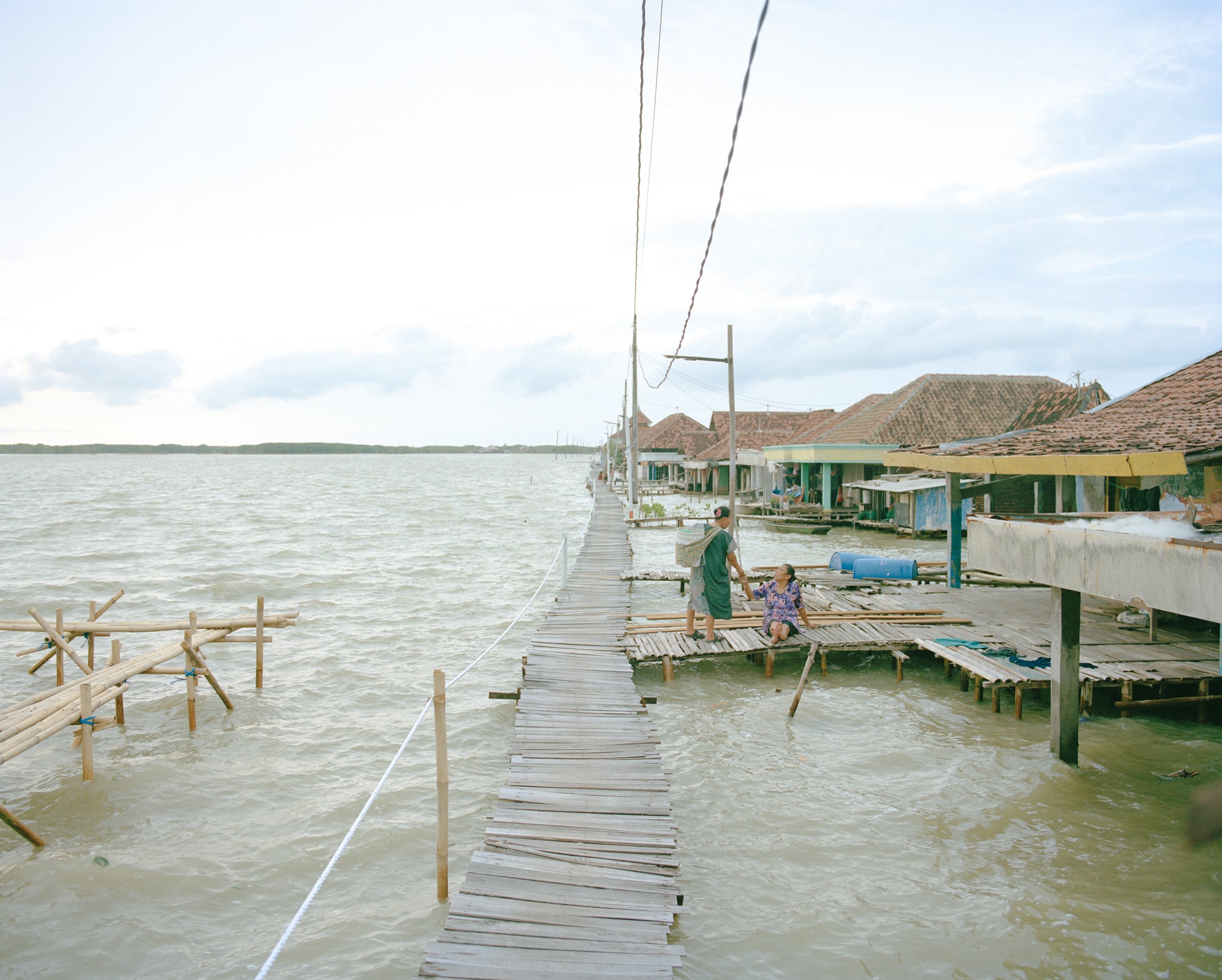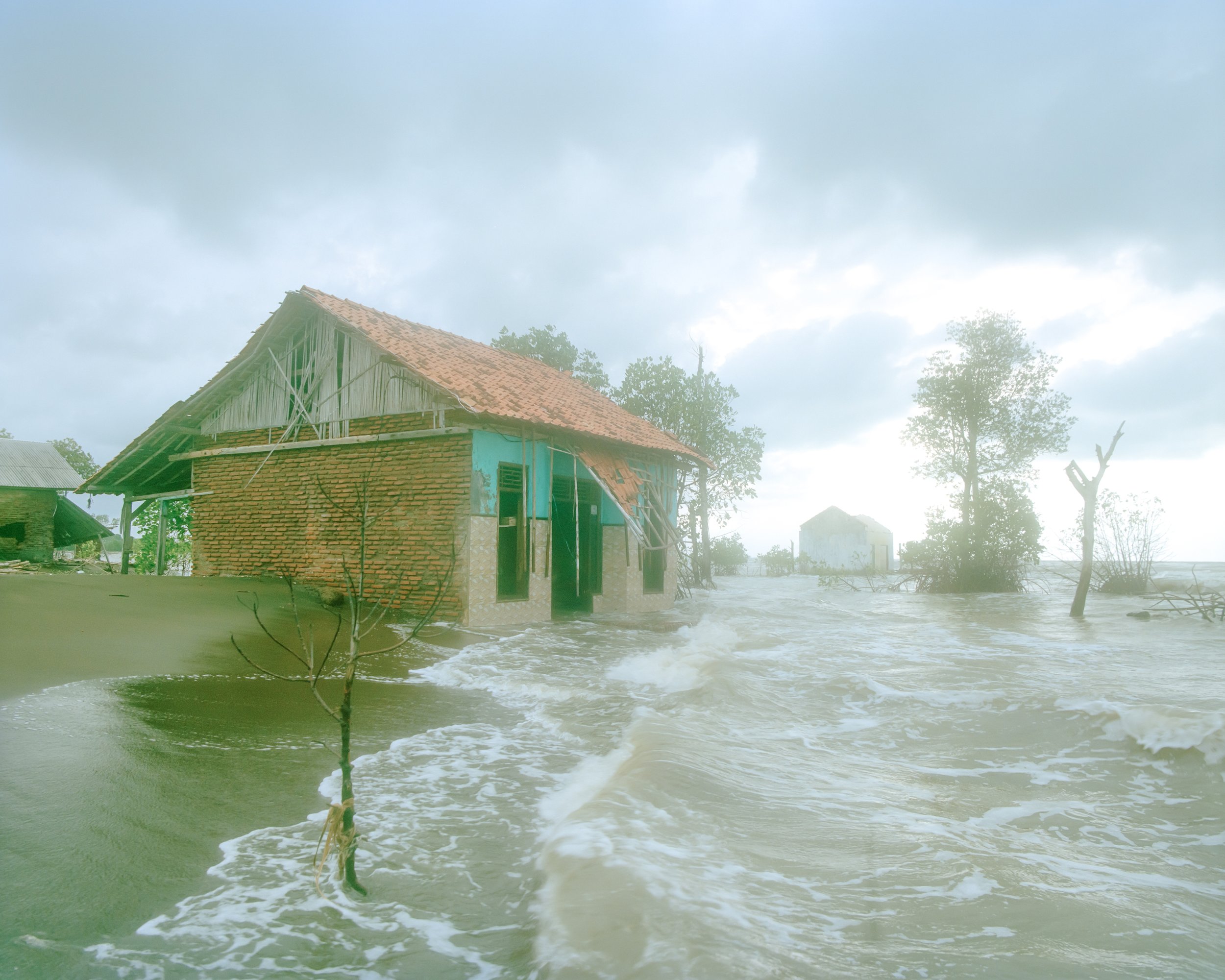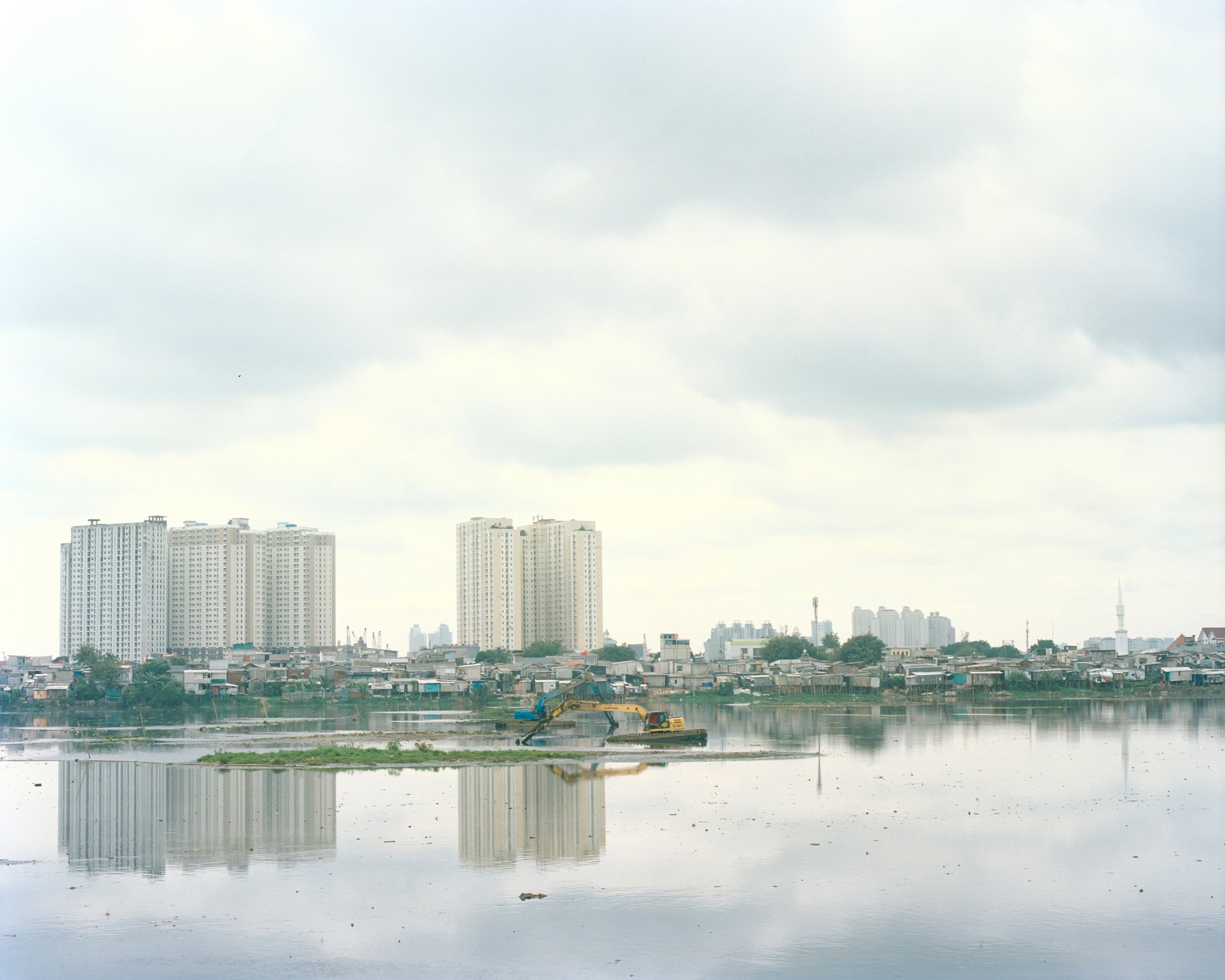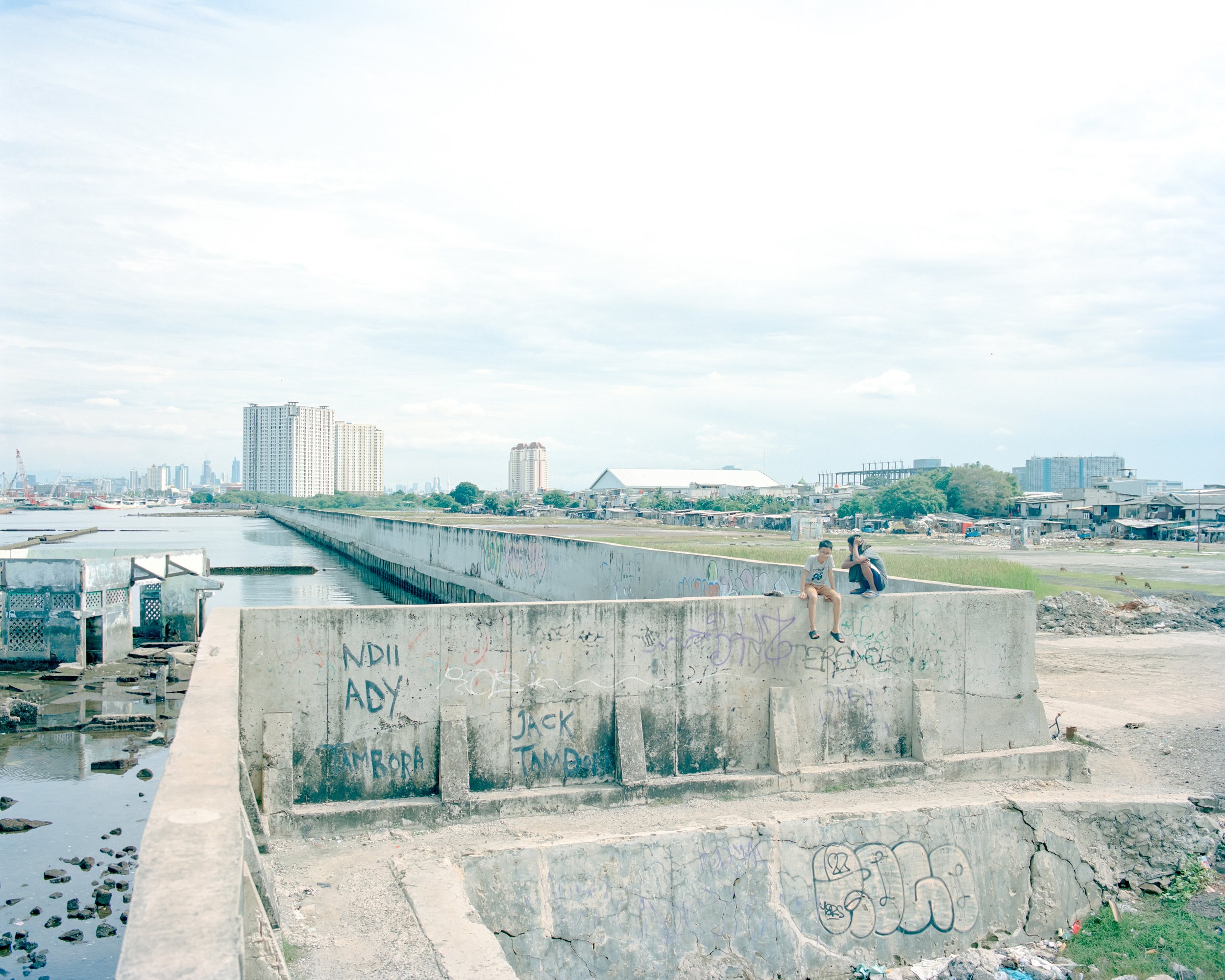
A woman comes back from a public water place with a natural pond. Many women and girls engage in this daily work every morning, even though it is hard to get fresh water in Gabura Union due to rising salinity levels in water resources.

An elderly man carries straw, Gabura Union, Bangladesh. Depopulation and an aging workforce, caused by the influx of younger generations associated with climate change into urban areas, have become new problems in rural areas of Bangladesh.

View of the inland of Gabura Union, Bangladesh, November 2021. Salinity intrusion caused by storms, floods, or rising water levels into soil and water resources makes it nearly impossible to grow plants in such a place, even though many people in rural areas in Bangladesh depend on rice production.

Men flatten the road to sandbag a bank, Gabura Union, Bangladesh. Cyclones, floods, and landslides often destroy many riverside roads in the Gabura Union. Therefore, people repeatedly repair roads whenever they collapse.

A fisherwoman catches small fish near the sandbags that have gradually sunken into the river due to rising water levels and intensifying storm surges caused by cyclones, Gabura Union, Bangladesh. These sandbags have not fulfilled their role due to the impacts of intensifying and frequent storm surges and rising water levels caused by tropical cyclones, even though they were constructed to protect residents from such natural disasters.

A fisherwoman who looks for places that can catch fish or shrimp in the pond.

Boys play near a house that has been broken by 2009 cyclone in Gabura Union, Bangladesh.

A young herdsman tends scrawny cattle after a massive flood in Sylhet, Bangladesh. Cattle in low-lying areas like Sylhet, one of Bangladesh's most flood-prone regions, often suffer from severe food shortages due to the loss of edible grass resulting from the flooding of grass fields after floods and cyclones.

Two women who walk on sandbags are pilled up in Gabua Union, November 2021. This road along the river collapsed because of rising water levels and river erosion. Residents of Gabura Union need to go to their destination on foot because it is difficult to use vehicles on sandbags.

A boy rows a wooden boat in the mangrove forest in Gabura Union, Bangladesh. This mangrove forest safeguards the residents of Gabura Union from natural disasters, including cyclones and storm surges. However, it has gradually diminished due to the impacts of intensifying cyclones and salinity intrusion.

Women wait for a boat to cross the river by the eroded riverbank in Sylhet, Bangladesh. Many places located near the river in Bangladesh have gradually been eroded by rising water levels and floods.

A man looks after his baby by the Kholpetua River.

Fishermen who fish on the Kholpetua River in Gabura Union, Bangladesh, November 2021. Such a peaceful scenery may be lost by the impacts of climate change in the not-too-distant future.

Men stay in the seawater near the breakwater under construction in Bohol Island, the Philippines. This area was severely damaged by Super Typhoon Rai (Odette) in 2021.

A boy relaxes on a hummock in a submerged house on Binuangan Island, Manila. Binuangan, located on Manila Bay, is one of the most vulnerable places to the impacts of rising sea levels and intensifying storm surges. Manila risks submersion due to ground subsidence caused by excessive groundwater pumping, rising sea levels caused by global warming, and intensifying storm surges. Therefore, flooding into houses happens every day at high tide time.

A girl looks outside the house in the rain in Binuangan Island, Manila, Philippines. Some people living on the outskirts of Manila face the crisis of submersion by subsidence caused by groundwater pumping and rising sea levels caused by tropical cyclones.

The boys play around a ramshackle house in Batasan Island, the Philippines. Batasan Island is among the areas most affected by rising sea levels. It is predicted to sink into the sea due to ground subsidence caused by the 2013 earthquake and storm surges caused by intensifying cyclones in the future.

The family has a peaceful time near the barricade that is under construction to protect residents from high waves in Bohol Island, the Philippines. This area was one of the most damaged places by Super Typhoon Rai (Odette) in 2021. Above all, some people living in coastal zones have lost their houses and property and have been forced to leave their hometowns.

The scenery of daily life in Timbulsloko has been gradually sinking due to the rising sea level. This village is located in the fastest-sinking area in Indonesia. (Indonesia, Central Java, Timbulsloko, 2025)

Waves crash on the abandoned houses. All the villagers have already left this village because it has been gradually sinking into the sea due to the severe impacts of rising sea levels. (Indonesia, Central Java, Pekalongan, 2025)

Excavators are pumping groundwater to solve the water shortage. One-third of Jakarta is likely to be submerged by 2050 due to subsidence caused by excessive groundwater extraction and rising water levels (Indonesia, Jakarta, 2025)

Boys who are relaxed on the seawall near an abandoned mosque that has already drowned at high sea level in the Muara Baru district, Jakarta (Indonesia, Jakarta, 2025)

A climate migrant boy who evacuated from the south coastal area due to river erosion sleeps in the bush near Dhaka station, Bangladesh. Dhaka is one of the most overpopulated cities and has many orphans from rural areas for various climate change reasons. Some orphans stay overnight in places such as stations, ferry terminals, roadsides, or under elevated tracks without anyone’s protection.

A climate migrant boy sleeps beneath the station passageway to shelter himself from the rainstorm. Many climate migrants live around the station in Dhaka, Bangladesh. Most pedestrians pass through the passageway without paying attention to people like the boy because this scenery is frequently seen around the station.

Climate migrant boys who inhale thinner on the roadside. They live on the roadside and make a living by begging and carrying luggage on the roads of Dhaka. Therefore, they are in constant danger, such as drug addiction, abuse from other homeless people, or traffic accidents. (Bangladesh, Dhaka, 2024)

A man who collects waste materials at the dump site in Dhaka, Bangladesh. Some climate migrants engage in such physical work or the manufacturing industry to earn a daily income; however, some of them are sometimes exploited in illegal and low-income jobs. (Bangladesh, Dhaka, 2024)

The boys play on garbage floating on the river by the Korail slum, Dhaka, Bangladesh, March 2024. More than 200,000 residents have lived in this slum, and many climate migrants who migrated from various areas such as Barisal, Bhola, Kuakata, or Chandpur to seek a stable, safe, and secure life are leading a life permanently or temporarily without an adequate subsidy from the government.

Portraits of the climate migrants. This picture shows the existence and faces of people that cannot be perceived in a statistical number.
This is an ongoing project examining the impacts of climate change through the portraits of climate migrants worldwide and the lives of people living in the midst of the climate crisis.
Residents of coastal regions in Asia and the Pacific, including Bangladesh, the Philippines, and Indonesia, face daily threats from floods, cyclones, land degradation caused by salinity intrusion, and land loss due to rising sea levels linked to global warming.
For a long time, people who are physically, mentally, and economically distressed have been forced to migrate to escape critical situations caused by the ever-increasing impacts of climate change, resulting in the loss of their homeland.
Individuals who become climate migrants relocate to urban areas in search of a sense of belonging and new job opportunities to earn a stable income.
However, the influx of migrants causes problems such as urbanization, housing shortage, and environmental pollution.
Moreover, employment in a new field without experience, skills, or qualifications can be challenging for migrants.
Since the Industrial Revolution, humankind has benefited from economic growth.
On the other hand, since the beginning of the 21st century, the global average temperature has been rising because of increased carbon dioxide emissions, and the impacts of climate change have been making life more difficult for humans.
Most of these burdens are imposed on people living in vulnerable areas, and this generates future climate migrants.
According to the World Bank, the number of climate migrants is estimated to increase to 216 million by 2050.
Therefore, the potential to become climate migrants is extremely high for all of us who have lived around the world.
This “The chronicle of us” is a record of the history of such human beings in the climate crisis.
Shunta Kimura
バングラデシュ、フィリピン、インドネシアを含むアジア・パシフィック地域沿岸部の人々は、温暖化がもたらす海面上昇に伴う土地の減少や、塩害による土地の不毛化、甚大な被害をもたらす台風や洪水の脅威にさらされながら日々の生活を営んでいる。
だが深刻化する気候変動の影響によって住み慣れた土地が徐々に消えゆく中、肉体的、精神的、経済的に疲弊した人々は、その危機的状況から逃れるために移住を選択せざるを得ない状況に追いやられる。
『気候移民』となった彼らは、新たな職や安心できる生活を求めて都市部へと向かうが、こうした移民の流入は都市を肥大化させ、住宅不足を生み、
さらに環境汚染などの問題の一因となってしまう。
また資格や経験がない分野での雇用は難しく、不安定な収入がさらなる貧困や治安の悪化を生み出している。
産業革命以降、経済成長による恩恵を人類は受けてきた。
しかし21世紀が始まって以降、二酸化炭素排出量の増加とともに世界の平均気温は上昇を続け、
気候変動の余波は人々の生活をより困難なものに変えている。
その重荷の大部分は脆弱な地域に住む人々にのしかかり、新たな気候移民を発生させる。
世界銀行は、2050年には世界中で発生する気候移民の数は2億1600万人に達すると警鐘を鳴らしており、地球に住むすべての人誰しもが当事者になる可能性は極めて高いだろう。
この“The chronicle of us”は、そのような気候危機の渦中を生きる人類の歴史の記録だ。
木村 旬太